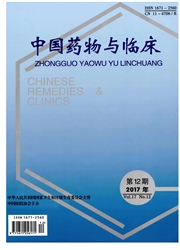

 中文摘要:
中文摘要:
目的研究氯沙坦(Los)对腹主动脉缩窄致慢性心力衰竭大鼠心室重塑和心功能的保护作用。方法SD大鼠40只,随机分为腹主动脉缩窄(COA)+Vehicle组,COA+Los组,假手术(Sham)+Vehicle组,Sham+LDs组。药物干预8周后采用超声心动图和心室插管法评估心功能,计算左、右心室质量指数(LVMI、RVMI),比色法检测心肌羟脯氨酸(HYP)含量,酶联免疫吸附试验(ELISA)检测心肌Ⅰ型和Ⅲ型胶原含量和比值,放射免疫法(RIA)检测心肌血管紧张素Ⅱ(AngⅡ)和醛固酮(ALD)水平。常规苏木素-伊红(HE)、Masson三色染色和透射电镜观察心肌组织形态学改变。结果与COA组相比,COA+Los组大鼠心功能和LVMI等指标明显好转,心肌HYP和Ⅰ型胶原含量降低,Ⅰ/Ⅲ型胶原比值降低;心肌AngⅡ和ALD水平降低;心肌组织形态改变明显好转。结论Los通过阻断AngⅡ与ATI—R结合,抑制心肌AngⅡ和ALD生成,从而改善心肌肥厚和胶原重构所致心室重塑,提高心功能,延缓心力衰竭进展。
 英文摘要:
英文摘要:
Objective To investigate the regulatory effect of Losartan (Les) on ventricular remodeling and cardiac function in chronic heart failure(CHF) rats induced by aorta coaretation (COA). Methods Forty Sprague-Dawley (SD) rats were randomized to receive abdominal aorta coarctation to induce CHF or sham operation and were treated with oral losartan (20 mg·kg^-1·d^-1) or vehicle (drinking water). As such there were four groups - COA+ vehicle group, COA+Los group, Sham+vehicle group and Sham+Los group. After 8-week treatment, ultrasound cardiography and catheterization were used to evaluate the cardiac function and left or right ventricular mass index (LVMI, RVMI). Level of myocardial hydroxyproline (HYP) was measured by chromometry. Levels of myocardium type Ⅰ and type Ⅲ collagens and their ratio were measured by ELISA. Levels of myocardial angiotensin Ⅱ (Ang Ⅱ) and aldosterone (ALD) were measured by RIA. The morphology of myocardium was studied with HE staining, Masson trichrome staining, and ultrastructure of myocardium was also observed. Results Lesartan-treated CHF rats had lower left ventricular end-diastolic pressure (LVEDP), higher left ventricular ejection fraction (LVEF) and lower left ventricle/body weight ratios, low- er levels of myocardium HYP, type Ⅰ collagen, and relative ratio and lower levels of Ang Ⅱ and ALD than vehicletreated CHF rats. By microscopy and TEM observation, the myocardial tissue in COA+ LOs group showed great improvement. Conclusion Losartan attenuated ventricular remodeling and improve cardiac function in aortic constricted rats by blocking angiotensin Ⅱ to bind AT1-R and reducing angiotensin Ⅱ and aldosterone in myocardium.
 同期刊论文项目
同期刊论文项目
 同项目期刊论文
同项目期刊论文
 Brain tumour necrosis factor-alpha modulates neurotransmitters in hypothalamic paraventricular nucle
Brain tumour necrosis factor-alpha modulates neurotransmitters in hypothalamic paraventricular nucle 期刊信息
期刊信息
